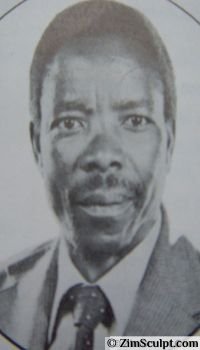Joseph Ndandarika died tragically in May 1991 at the age of 50: Zimbabwe mourned the loss of one of its most gifted and successful sculptors, believed by some, to be ranked amongst the worlds major artists. His background and upbringing was simple, but significant. Perhaps most important is the fact that he was the grandson of a highly respected n’anga (mystical healer and spiritual figure within Shona society). It is argued that there is much evidence in Joseph’s work of his time spent in apprenticeship with his grandfather -inheriting the powerful ancestral ways of his people.
In 1962 he joined Frank McEwen’s Workshop School in Harare as one of its first and most significant members . McEwen recognised his natural talent as he watched him work energetically and freely in a variety of media – beginning with painting and moving to sculpture through modelling and carving. He spoke of Joseph later as ‘ A great and universal genius who worked in every possible medium’. This lack of inhibition matured into an assured belief in himself as a consummate artist, and the strength and scope of his work grew accordingly.
His life took on all the appearances of an adept city dweller, but the legacy that now remains tells of a shy and gentle man who, to the end remained profoundly spiritual and troubled by the spectre of traditional cultural ties being threatened by much in modern Zimbabwean society. His friends and fellow sculptors talk of him with affectionate warmth as someone who, initially, may have appeared quiet and reserved, but with encouragement could emerge as acolourful and entertaining personality; but above all an artist with deep integrity and an increasingly determined drive to portray the spiritual beliefs and customs so vital to the lives of previous generations. We should perhaps be thankful for this possible dichotomy within the one man – what may well have caused Joseph much anguish and struggle also resulted in the portrayal of the gamut of human experience – both physical and metaphysical. His sculpture is capable of expressing searing grief and loss; the fragility of our earth -bound existence; the humour and love that is possible in human relations; and the constant presence of spiritual powers and links with previous generations. His own knowledge of tragedy and conflict are not perhaps unique, but his familiarity, not only with the extremes of human experience, but also with the spiritual potential of life combines to express powerful and universal truths.
He worked endlessly with the figure – as a means of portraying elements of both worlds. Enlarged heads signifying the home of the spirit and the potential of physical endeavour; definitively carved faces expressing the depths of the human soul; arms that envelope and share such experiences; and always the inescapable solidity of the stone and the human form. Some gesture appears unconsciously captured, elsewhere it is didactic and purposeful.
In almost all of Joseph Ndandarika’s work he seemed able to portray the experiences and dilemmas of life, not only with a consummate skill, but with an understanding and expression that eludes most of us. His work has been exhibited and collected worldwide and awarded the highest critical acclaim.



